The chime of cymbals echoes through the underpass beneath Urban Park, ringing with the familiar babble of the fountains.
The knell is a new addition to the area’s soundscape and comes as part of a work commissioned for the Public Art Abu Dhabi Biennial. The work by Lawrence Abu Hamdan is titled The Conversation. It features a set of cymbals that are struck by a mechanism fed by the running water of the fountains. The work references the 1974 Francis Ford Coppola film and obscures a scripted exchange with the sounds of water and alloy.
The Conversation adds to another similar work by Hamdan at the biennial. Wsh Wsh is fitted on the fountains circling the Abu Dhabi Chamber of Commerce and Industry. The installation pays tribute to the fountains found in traditional Damascene courtyards, where the sounds of water would often conceal private conversations.
The two installations draw renewed attention to the fountains in the area, accentuating them with a new layer of meaning. In that sense, it is much like the rest of the works at the inaugural biennial, which celebrates existing features across Abu Dhabi’s public spaces by introducing new, often surprising elements.
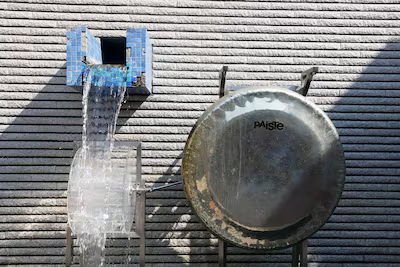
“Weaving art within significant sites of our Abu Dhabi cities is the mission of our first Public Art Abu Dhabi Biennial,” Mohamed Khalifa Al Mubarak, chairman of the Department of Culture and Tourism – Abu Dhabi tells The National.
“This initiative reminds our audience about the cultural vision of our emirate as a centre for culture and creativity, and ensures that art goes beyond closed walls to enable transformative, inclusive and accessible encounters for both our residents and visitors.
"It represents our culture sector’s vision to embed art within the very fabric of the emirate, ensuring that creativity and inspiration are part of everyday life, and reflects our commitment to supporting creatives in Abu Dhabi, the Global South and the rest of the world through inspirational artistic programmes.”
More than 70 local and international artists are taking part in the inaugural event, displaying works across public spaces in the capital, from the Corniche and the public park network to the bus terminal, carpet souq and Al Ain Oasis.
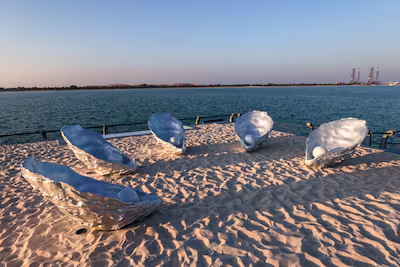
Several works draw inspiration from local sources. Homesickness by Farah Al Qasimi, for instance, depicts five large oysters on a platform on the Corniche. The oysters are fitted with concealed speakers that play a piece of music inspired by Tob, Tob Ya Bahar, a traditional chant once sung by the wives of pearl divers.
Barzakh by Wael Al Awar, meanwhile, presents a large dome structure, also on the Corniche. The structure, however, proposes sustainable solutions to global environmental problems by incorporating materials derived from industrial waste, as well as those that were used in vernacular architecture. The materials included recycled plastics and palm fibre. It also makes use of brine, a by-product of the water desalination process.
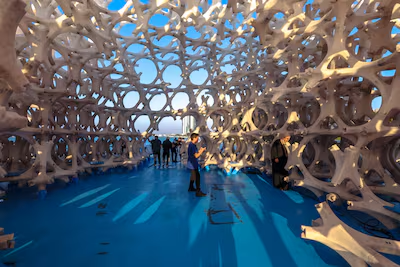
Then there are installations meant to engage the public in whimsical ways. Pawel Althamer’s Tentarium, for instance, is a sprawling homage to the cats of Abu Dhabi. Displayed on Lake Park, the tent is shaped like a cat, fitted with ears and eyes on one end and a tail affixed on the other end. The interior invites visitors to draw, paint and write on its canvas walls. The installation is expected to drastically change as the biennial progresses, and will embody Abu Dhabi’s cosmopolitan nature with its mixture of languages and cultural references.
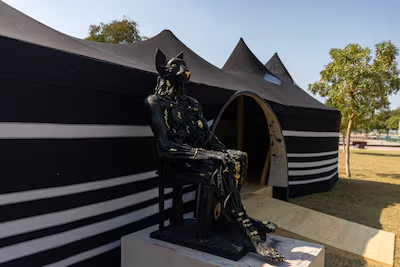
Seema Nusrat’s Floating Fragments presents a cautionary tale in the centre of the waters of Lake Park. Terracotta roofs peek out the body of water, reimagining the lake as the scene of a flood that has submerged entire homes. The installation highlights the risks of extreme weather changes incurred by climate change.
In Kombwelo 504, Sammy Baloji highlights topics of resource extraction through the window of a cultural motif prevalent in the Congolese collective consciousness. The installation recreates a Peugeot 504 car, once regarded as a status symbol in the Democratic Republic of Congo. The car, however, has been made using copper wires, reflecting a practice by Congolese children to fashion toys from discarded materials. Plants from the Congo and the UAE grow within Baloji’s copper car, nourished by the municipal irrigation system.
Christoper Joshua Benton, on the other hand, takes on the carpet souq with a design of his own. Where Lies My Carpet is Thy Home was developed in collaboration with the merchants of the souq and brings together cultural identities from Afghanistan, India and Pakistan. Rendered on astroturf and in an 8-bit pixel aesthetic, the design depicts the life of a carpet, going from its beginnings as loose wool to its presentation at the market.
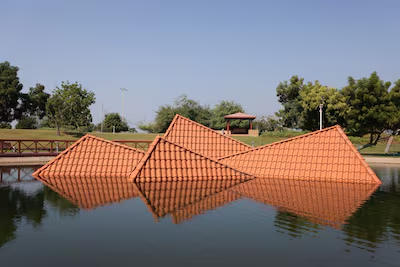
Afra Al Dhaheri’s installation offers refuge from the bustle and pace of city life. D-Constructing Collective Exhaustion is made of wooden structures, tangled ropes, light and sound. The installation aims to instil a meditative feeling among visitors, helping them establish a balance between their physical and mental space.
One of the most powerful works at the biennial is Khalil Rabah’s Among Trees. The installation comprises 15 olive trees presented in metal containers. Some of the trees remain stationary, others rotate on gyrating platforms. While the piece is inspired by the cyclical dances of Sufi rituals, it also brings to mind the human relationship to land, highlighting experiences of movement and displacement.
Each of the works presented at the biennial is thought-provoking in its own right, and sharply responds to their setting. Alia Lootah, a member of the curatorial team, says this is because artists directly developed their works based on where they would be displayed.
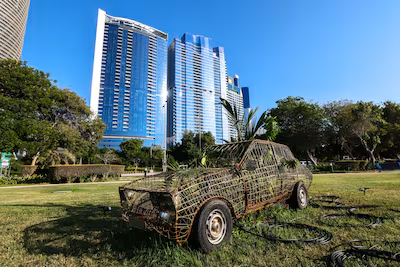
“We were looking at artists who either work with the community or have done public art, or we felt that their work is connected to the landscape of Abu Dhabi,” Lootah says. “But we also made sure that all the artists came for site visits to actually see Abu Dhabi on the ground.”
The artists also took part in discussions about the history of Abu Dhabi, learning more about its different communities and public spaces. “We had the locations that we wanted to work with in mind,” Lootah says. “We wanted really to highlight where people gather, and where the public enjoys the city of Abu Dhabi on foot. We're creating these works for the locals, for the people living here, for the residents, and also for the visitors.”
Lootah says that new works will also added to the biennial in January, while different performances, workshops and programmes will be held throughout the six months.
The curator also hinted that several of the artworks being showcased will become permanent fixtures in the city’s landscape. However, a lot will depend on public interaction.
“We have a list of artworks that are possibly going to be permanent,” she says. “But we also like to see how people interact with the artworks to make sure that this is what the people want before we take the decision.”





